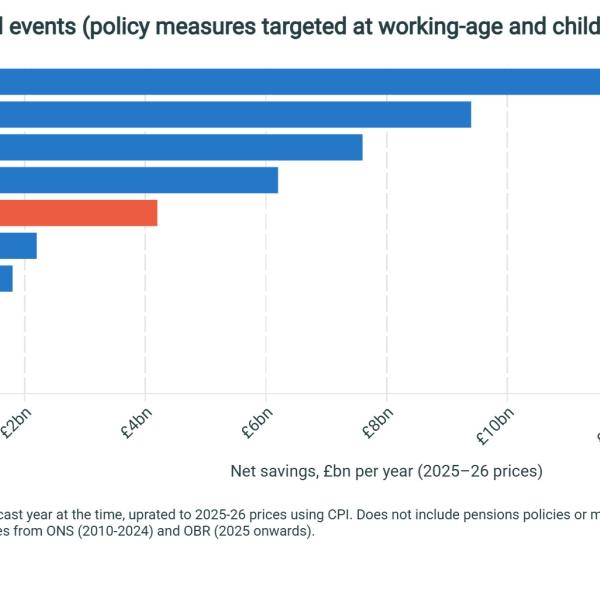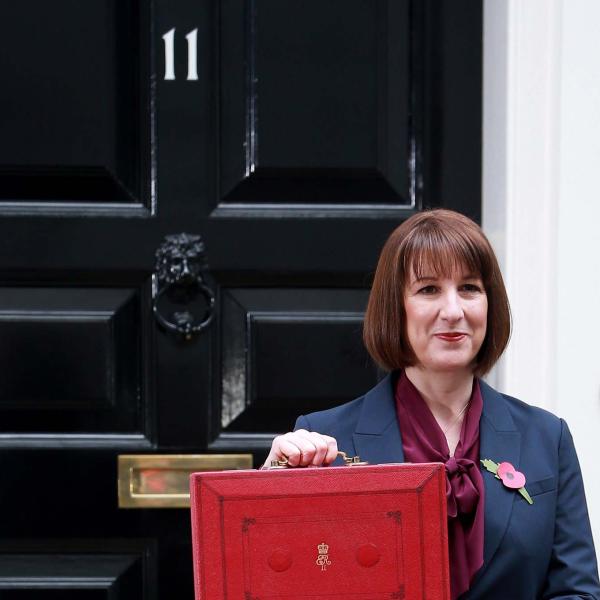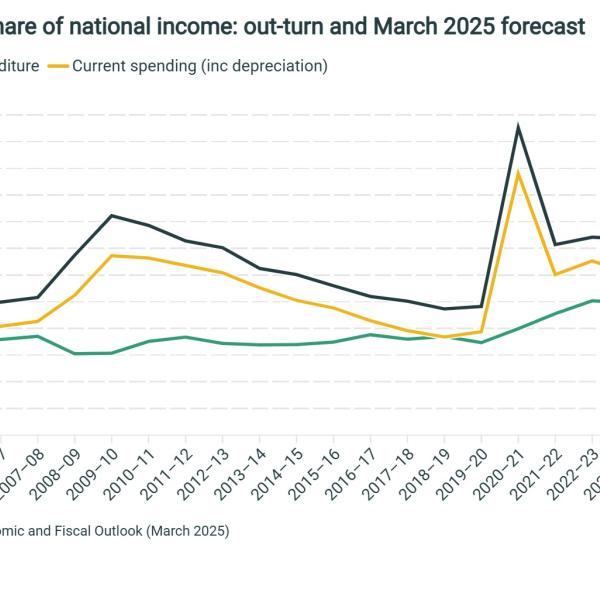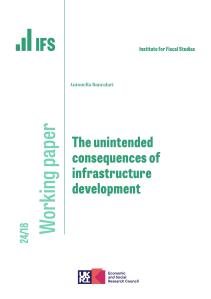What is public investment?
Public investment, or public capital expenditure, is spending by the state on the creation of fixed, long-term assets. The classic examples are spending on physical assets such as roads, buildings, bridges and tunnels – things that last. This is distinct from ‘current’ expenditure – i.e. spending that does not create fixed assets (such as spending on the state pension, drugs for NHS patients or the wages of civil servants) – which makes up the majority of total government expenditure.
Public investment is important partly because it supports the delivery of public services – for example, providing schools for pupils to learn in or hospitals for doctors to operate in. It also plays a role in shaping wider economic growth. A reliable transport network can support the economy by facilitating the movement of goods and people, for example, and public investment in R&D can support – and influence the direction of – technical innovation, including by ‘crowding in’ private investment. Depending on the specific measure used, the public sector currently accounts for roughly 15–20% of total investment in the UK; the rest comes from individuals, UK businesses and foreign direct investment.
How do we measure public investment?
The most commonly used measure of UK public investment is public sector net investment (PSNI). This, in turn, is defined as public sector gross investment (PSGI, a measure of the cash amount of capital expenditure net of any receipts from asset sales) minus depreciation (a measure of the reduction in the value of an asset over time, typically due to wear and tear). In other words, PSNI is an estimate of the amount of investment in new assets, net of the spending needed to maintain the assets we already have. Most, but not all, public investment in the UK is done by (or on behalf of) central government departments; this is discussed below.
For international comparisons of investment, the measure generally used is called gross fixed capital formation (GFCF), which has a standard definition across countries and sectors. Like PSGI, it is measured gross of depreciation. GFCF is a somewhat narrower definition than PSGI, however, as it excludes capital grants (also discussed below).
What do current government and Labour party plans imply for overall public investment?
It is helpful to express the level of public investment spending as a percentage of national income (GDP), as this gives a sense of what fraction of national resources is being devoted to investment.
Over the 45 years from 1978–79 to 2022–23, public sector net investment (PSNI) averaged 1.6% of national income, though it has been above that level in all but one year since 2003–04 (Figure 1). The decline in public investment over the 1980s partly reflects the changing boundaries of the state as numerous formerly nationalised industries moved into the private sector (whole economy investment actually increased over the 1980s). Over the 25 years from 1998–99 to 2022–23, PSNI averaged 1.8% of national income. The latest official figures suggest that PSNI in 2024–25 (the fiscal year in progress) will amount to 2.4% of national income, a relatively high level by recent UK standards.
Current government policy is for gross investment spending (PSGI) to be more-or-less frozen in cash terms after this year: official plans have it falling slightly from £136.0 billion in 2024–25 to £130.6 billion in 2028–29. Depreciation – roughly, the amount of wear and tear on public sector assets – is expected to grow from £69.4 billion in 2024–25 to £77.5 billion in 2028–29, in part because higher levels of investment in recent years mean that there are now more assets that suffer from wear and tear. PSNI, defined as PSGI minus depreciation, is therefore set to decline from £66.6 billion in 2024–25 to £53.1 billion in 2028–29.
In real terms (i.e. after adjusting for inflation, as measured by the GDP deflator), that will equate to cuts to net investment of around 7% per year. This reduction, combined with a growing economy, is set to result in a sharp decline in PSNI from 2.4% of national income in 2024–25 (a relatively high starting point, by UK standards) to 1.7% of national income in 2028–29. To avoid making real-terms cuts to PSNI after this year would require spending plans for 2028–29 to be topped up by around £18 billion. To maintain net investment at its 2024–25 level of national income (2.4%) would require 2028–29 spending plans to be topped up by £24 billion.
On the assumption that gross investment is frozen in cash terms for another year, PSNI would fall further to 1.5% of national income in 2029–30, below the average level observed since 1978–79, and even further below the average observed since 1998–99. This is displayed in Figure 1.
The Labour party recently rowed back from its high-profile £28-billion-a-year ‘Green Prosperity Plan’ (previously analysed here). The latest iteration of its plans is for an additional £23.7 billion of investment spending over the next parliament (equivalent to around £4.7 billion extra each year). Figure 1 shows what (under a reasonable set of assumptions) this would mean for the overall level of public investment. This additional investment would not be enough to offset the cuts pencilled in by the current government (nor, it should be noted, would the previous version of Labour’s green investment plans have been). PSNI would still be falling sharply as a share of national income under Labour’s proposed plans, just not quite as sharply as under the plans of the current Conservative government. Of course, plans change, and if Labour – or, for that matter, the Conservatives – win the election, they might end up spending more or less than this.
Are cuts to investment required to meet the government’s fiscal rules?
Both the Conservative and Labour parties are (at the time of writing) committed to a fiscal rule that requires government debt to be falling as a share of national income between the fourth and fifth years of the forecast. Both parties have additional fiscal rules, but in present circumstances (with elevated debt and debt interest spending and weak forecasts for economic growth), the debt target is the rule that binds. In other words, it is the debt target that will likely constrain the ability of the post-election Chancellor to cut taxes and/or increase spending.
Importantly, the debt target makes no distinction between borrowing for different purposes. Whether the government borrows to cut taxes, to increase public sector wages or to spend more on infrastructure investment, it adds to debt all the same and so is treated identically in this fiscal rule. In order to meet the debt target, the government has pencilled in large cuts to public investment (described above, along with a tight set of day-to-day spending plans for public services and some large tax rises via an ongoing freeze to income tax thresholds).
These cuts to public investment are not unavoidable, however. This government – or a future Labour government – could maintain or even boost investment spending and stay within its fiscal rules if it were willing to finance the extra investment through (further) tax rises or cuts to day-to-day spending. In other words, the target for government debt to be falling in five years’ time does not ‘require’ cuts to investment in any meaningful sense. Rather, those cuts are only ‘required’ to meet the fiscal rule because of an unwillingness or political inability to prioritise investment over spending on consumption and/or an unwillingness to raise taxes.
Do the fiscal rules prevent the government from borrowing to invest?
The target for debt to be falling in five years’ time does, however, constrain the government’s ability to borrow to invest.
The government has left itself an extremely narrow margin – a very small amount of so-called ‘headroom’ – against its debt rule. For that reason, absent an improvement in the growth outlook, a substantial increase in borrowing for investment (which is treated the same as borrowing for any other purpose) is highly likely to breach the fiscal rule by putting debt on a rising path as a share of national income.
The debt target is, ultimately, self-imposed. It is also a poorly designed fiscal rule (something that has been extensively discussed elsewhere ). Other fiscal rules are, of course, possible. Indeed, an economic case can be made for higher levels of borrowing for investment, even if this means a higher debt-to-GDP ratio: if the additional investment sufficiently expands the supply side of the economy and/or creates productive public sector assets, this could increase the government’s ability to service that debt in future. The level of debt is not the only thing that determines whether or not it is sustainable, and a focus on only one side of the government balance sheet – i.e. looking only at liabilities (debt), and not at assets – can paint a misleading picture.
This is an important debate. We do not seek to do it full justice here, but there are three points worth highlighting.
First, debt dynamics in the UK and elsewhere are increasingly unfavourable, and the creation of illiquid public sector assets will not necessarily make the UK government better placed to access capital markets or service its debt (discussed in more detail here). There are, therefore, good reasons not to be too relaxed about debt-financed public investment: there is some limit, even if we can’t be certain where that limit lies.
Second, we should be careful not to equate investment with ‘growth-enhancing’ spending: not all investment is productive and not all investment will enhance the supply side of the economy. In particular, much ‘green’ investment can be thought of as allowing us to produce the same amount of GDP in a less environmentally damaging way, rather than allowing us to produce more GDP. That doesn’t mean that we shouldn’t do it, but it does mean that we should be sceptical about claims that it will pay for itself by providing a major boost to growth.
Third and finally, any increase in investment – debt financed or otherwise – might helpfully be coupled with a greater focus on ensuring that it is well executed, realistic and economically worthwhile (whether because we can be confident it will be genuinely growth-enhancing or because it will bring other benefits). That should include consideration of whether institutional reforms (such as the involvement of the National Infrastructure Commission in the budget-setting process) might make that more likely, and a continued focus on what might be done to reduce costs and project delays (which the evidencesuggests might be greater in the UK than elsewhere).
Is all ‘investment’ in tangible assets?
When we talk about ‘investment’, we usually have in mind spending on tangible assets – things such as new hospitals, new railway lines or new aircraft carriers. This is certainly a big chunk of public investment. But official measures of investment (such as PSGI and PSNI) also include other items we might not immediately think of as ‘investment’.
Student loans are perhaps the most notable example. On average, the cohort of students who entered university in the autumn of 2023 can expect to pay back around 70% of their student loans according to official estimates, with the rest written off after 40 years. This written-off portion is counted immediately as a ‘capital grant’. It is counted as part of PSNI but excluded from measures of GFCF. The sums involved are non-trivial: student loans added around 0.5% of national income to PSNI in recent years (Figure 2), equivalent to more than one-fifth of the total. In contrast, student loans added nothing to PSNI prior to 1998, and added only a very modest amount prior to the 2012 student loan reforms.
To some extent, this ‘flatters’ the headline investment figures and perhaps overstates the extent to which the UK has been investing more in recent years than in the past. For instance, headline PSNI in 2021–22 was comfortably above its pre-financial crisis level in 2007–08 (2.3% versus 1.8%). But after stripping out the effect of student loans, this is no longer the case and investment levels were broadly identical.
Reforms to the student loans system can also complicate comparisons of PSNI across time: the contribution of student loans towards PSNI fell to almost zero in 2022–23 before bouncing back to 0.4% of national income in 2023–24, contributing to the apparent spike in PSNI in that year.
From an accounting perspective, the treatment of student loans in the national accounts might make sense. But from an economic perspective, it seems perverse. The government in 2013 described capital spending as being ‘money that is spent … on things that will create growth in the future’. Yet loans to students who go on to earn high amounts and pay off their loans in full do not count as investment, while loans that are written off (because the student never earns enough to pay it back) add to measured investment – even though the latter might be considered less likely to ‘create growth in the future’.
Should we have a broader definition of ‘investment’?
The student loans question relates to a broader issue around the misalignment between accounting measures of investment and what we might call ‘growth-enhancing spending’, even though the two are often used interchangeably. While the accounting definition of capital spending can serve as a helpful rule of thumb for the sorts of spending that will bring long-term economic benefits, it is an imperfect one. To take one example, spending on early years education might deliver substantial long-term economic benefits in the form of enhanced ‘human capital’, but is classified as ‘current’ spending in the national accounts.
Politicians frequently fudge the definition of investment, talking about ‘investing’ in childcare, healthcare or policing. But there are also occasional calls for some types of current spending to be reclassified more formally as ‘investment’.
It is important here to distinguish between changing the accounting definition of investment (which is based on the Office for National Statistics applying internationally agreed definitions), and changing how different types of spending are classified for the purposes of the fiscal rules. Until this point, the definitions used in each case have tended to be the same.
Often when people call for (for example) education spending to be reclassified as investment, what they really mean is that the fiscal rules should allow for borrowing for ‘investment’ in education and not just investment in roads and buildings. This is a reasonable position to hold, given the potential benefits of education spending for future economic growth. But if a government wishes to borrow to spend more on investments in human capital, it can do so without fiddling with internationally agreed accounting definitions. There is nothing to stop a Chancellor designing a set of fiscal rules that allow for borrowing to pay for only ‘growth-enhancing spending’ or ‘spending that benefits future generations’.
There are two challenges with such an approach. The first is simple: if the fiscal rules allow the government to borrow for ‘traditional’ investment as well as for other types of spending that the government argues will benefit future generations, that is very likely to mean higher levels of borrowing – perhaps much higher. Adherence with the government’s fiscal rule might cease to be a reasonable proxy for fiscal sustainability. The second challenge is one of definitions. The line between the different categories of spending has to be drawn somewhere, and departments would inevitably lobby to have their projects included. For instance, bad population health is bad for labour market participation (and hence growth), but how much of the NHS budget ought to be classified as ‘investment’ as a result? Crime is known to depress economic growth – should prison guards’ salaries be counted as investment too? In any case, there would surely be suspicions that if the definition were entirely within the control of the Chancellor, that definition would be fudged to meet the letter of the fiscal rules and/or make the government’s life easier politically.
It is cleaner and simpler to stick with the existing, well-defined distinction between current and capital spending, including for the fiscal rules. But accounting treatment should not govern economic policymaking. Government spending should ideally be allocated to where it delivers the biggest benefits, whether those benefits are realised in the short term or further into the future. If a government wishes to borrow to spend more on education (or anything else) because it thinks the long-term benefits would justify doing so, it should make the case on those terms. This issue is discussed in more depth in box 5.1 of the 2021 IFS Green Budget.
What do existing plans imply for capital spending by departments?
The funding allocated to central government departments for capital spending is known in the fiscal jargon as capital departmental expenditure limits, or CDEL. Rather confusingly, there are two measures of CDEL: the headline measure used by HM Treasury for the purposes of controlling departmental spending (planned to be £118.1 billion in 2024–25), and a measure used by the Office for Budget Responsibility for the purposes of fiscal forecasting (PSGI in CDEL, £99.2 billion in 2024–25). The second measure is smaller because it excludes some funding that is included in CDEL but not in PSGI (such as intergovernmental leases) and because it accounts for the OBR’s assumption that some of the allocated funding won’t ultimately be spent (the OBR publishes a reconciliation of the two measures alongside each Budget).
Figure 3 shows how capital spending by departments (under the OBR measure) has evolved since 1998–99 (when the split between departments’ day-to-day and capital budgets was introduced). Spending grew very quickly during the 2000s, was cut back very sharply after 2009–10, and has then steadily increased since around 2016. Over this parliament, overall capital funding for departments has increased by around 40%. But after this year, the planned cash freeze in budgets (described above) is set to deliver substantial real-terms cuts to capital funding (with even larger cuts in real per-person terms or as a percentage of national income – as shown in Figure 3).
Capital funding for departments is quite concentrated: four departments – Transport, Defence, Science, Innovation and Technology, and Health and Social Care – account for more than half of the total (Figure 4). This has implications for what lies in store at the next Spending Review. With an overall cash freeze pencilled in, departments are facing real-terms cuts to their capital budgets of around 2.0% per year on average. But if one of these bigger departments is treated more favourably, the cuts for all other areas could grow quite substantially. For instance, if the Ministry of Defence capital budget is increased in line with the government’s newly announced plans for overall defence spending (to reach 2.5% of GDP by 2030–31), the average real-terms cut for other departments would rise from 2.0% to 3.1% per year. If extra capital funding were also provided to other priority areas, the cuts for remaining budgets would be deeper still. For example, the National Audit Office notes that an ‘indicative’ £18.5 billion of funding has been agreed for the NHS’s new hospitals programme between 2025–26 and 2030–31, around £3 billion per year. That, too, would eat into the amount available for other areas.
How does the UK compare internationally?
Levels of investment are lower in the UK than in many other advanced economies. That is particularly true of whole economy investment (i.e. the sum of both public and private investment), as illustrated in Panel A of Figure 5. Since 1995, the UK has tended to have the lowest level of investment as a percentage of national income in the G7 (though was pipped to the post by Italy between 2015 and 2019). This pattern partially reflects the UK’s sectoral mix: the UK has a relatively services-oriented economy, and sectors such as finance and professional services, by their nature, require less capital investment than sectors such as manufacturing. For that reason, we might expect investment levels in the UK to be below those seen in less service-focused economies – though this is far from the only explanation.
Public investment levels in the UK have also tended to be lower than those in many comparable economies (shown in Panel B of Figure 5, with ‘public investment’ defined here as GFCF by general government), though this is less the case now than it used to be. Since 2014, government investment in the UK has exceeded the levels seen in Italy and Germany, though it has consistently lagged behind the levels seen in Japan, France, the US and Canada.
Summary
Public investment is a policy issue of central importance for public service delivery, economic growth, the UK’s climate ambitions, and much else besides. Indeed, many economists view low rates of public investment as a key contributing factor to the UK’s lacklustre productivity performance. Both the Labour and Conservative parties are presently committed to spending plans that would see public investment decline as a share of national income over the next parliament. Both are also committed to a fiscal rule that requires debt to be stabilised by the end of the forecast period; in present circumstances, that constrains the ability of the government to borrow to invest. The question then becomes one of how much to prioritise investment for tomorrow versus consumption today. This will be a key political trade-off for the next government.










